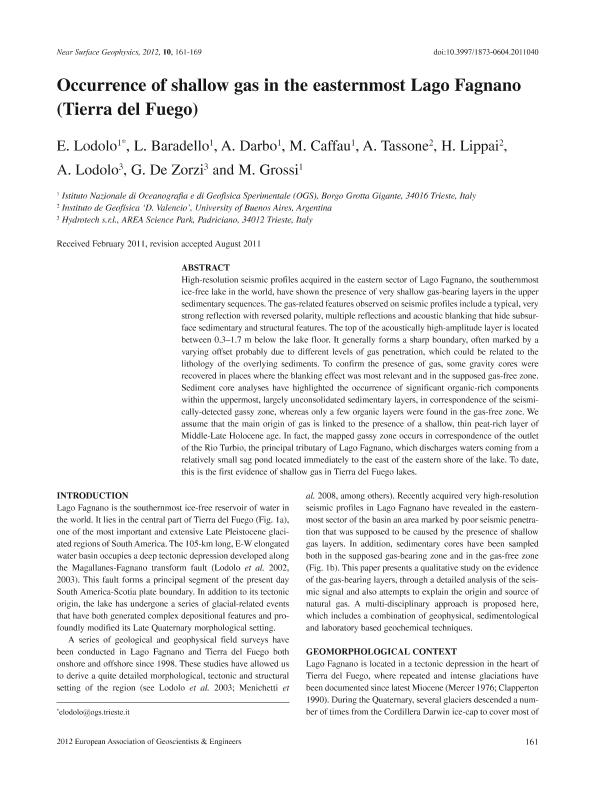Mostrar el registro sencillo del ítem
dc.contributor.author
Lodolo, Emanuele

dc.contributor.author
Baradello, L.
dc.contributor.author
Darbo, A.
dc.contributor.author
Caffau, Mauro

dc.contributor.author
Tassone, Alejandro Alberto

dc.contributor.author
Lippai, Horacio Francisco

dc.contributor.author
Lodolo, A.
dc.contributor.author
De Zorzi, G.
dc.contributor.author
Grossi, M.
dc.date.available
2019-01-17T22:37:29Z
dc.date.issued
2012-04
dc.identifier.citation
Lodolo, Emanuele; Baradello, L.; Darbo, A.; Caffau, Mauro; Tassone, Alejandro Alberto; et al.; Occurrence of shallow gas in the easternmost Lago Fagnano (Tierra del Fuego); European Association of Geoscientists & Engineers; Near Surface Geophysics; 10; 2; 4-2012; 161-169
dc.identifier.issn
1569-4445
dc.identifier.uri
http://hdl.handle.net/11336/68243
dc.description.abstract
High-resolution seismic profiles acquired in the eastern sector of Lago Fagnano, the southernmost ice-free lake in the world, have shown the presence of very shallow gas-bearing layers in the upper sedimentary sequences. The gas-related features observed on seismic profiles include a typical, very strong reflection with reversed polarity, multiple reflections and acoustic blanking that hide subsurface sedimentary and structural features. The top of the acoustically high-amplitude layer is located between 0.3-1.7 m below the lake floor. It generally forms a sharp boundary, often marked by a varying offset probably due to different levels of gas penetration, which could be related to the lithology of the overlying sediments. To confirm the presence of gas, some gravity cores were recovered in places where the blanking effect was most relevant and in the supposed gas-free zone. Sediment core analyses have highlighted the occurrence of significant organic-rich components within the uppermost, largely unconsolidated sedimentary layers, in correspondence of the seismically-detected gassy zone, whereas only a few organic layers were found in the gas-free zone. We assume that the main origin of gas is linked to the presence of a shallow, thin peat-rich layer of Middle-Late Holocene age. In fact, the mapped gassy zone occurs in correspondence of the outlet of the Rio Turbio, the principal tributary of Lago Fagnano, which discharges waters coming from a relatively small sag pond located immediately to the east of the eastern shore of the lake. To date, this is the first evidence of shallow gas in Tierra del Fuego lakes.
dc.format
application/pdf
dc.language.iso
eng
dc.publisher
European Association of Geoscientists & Engineers

dc.rights
info:eu-repo/semantics/openAccess
dc.rights.uri
https://creativecommons.org/licenses/by-nc-sa/2.5/ar/
dc.subject
Sismica
dc.subject
Gas
dc.subject
Lago Fagnano
dc.subject
Tierra del Fuego
dc.subject.classification
Meteorología y Ciencias Atmosféricas

dc.subject.classification
Ciencias de la Tierra y relacionadas con el Medio Ambiente

dc.subject.classification
CIENCIAS NATURALES Y EXACTAS

dc.title
Occurrence of shallow gas in the easternmost Lago Fagnano (Tierra del Fuego)
dc.type
info:eu-repo/semantics/article
dc.type
info:ar-repo/semantics/artículo
dc.type
info:eu-repo/semantics/publishedVersion
dc.date.updated
2019-01-16T18:20:03Z
dc.journal.volume
10
dc.journal.number
2
dc.journal.pagination
161-169
dc.journal.pais
Países Bajos

dc.journal.ciudad
Houten
dc.description.fil
Fil: Lodolo, Emanuele. Istituto Nazionale di Oceanografia e di Geofisica Sperimentale; Italia
dc.description.fil
Fil: Baradello, L.. Istituto Nazionale di Oceanografia e di Geofisica Sperimentale; Italia
dc.description.fil
Fil: Darbo, A.. Istituto Nazionale di Oceanografia e di Geofisica Sperimentale; Italia
dc.description.fil
Fil: Caffau, Mauro. Istituto Nazionale di Oceanografia e di Geofisica Sperimentale; Italia
dc.description.fil
Fil: Tassone, Alejandro Alberto. Consejo Nacional de Investigaciones Científicas y Técnicas. Oficina de Coordinación Administrativa Ciudad Universitaria. Instituto de Geociencias Básicas, Aplicadas y Ambientales de Buenos Aires. Universidad de Buenos Aires. Facultad de Ciencias Exactas y Naturales. Instituto de Geociencias Básicas, Aplicadas y Ambientales de Buenos Aires; Argentina. Universidad de Buenos Aires. Facultad de Ciencias Exactas y Naturales. Departamento de Geología. Instituto de Geofísica "Daniel Valencio"; Argentina
dc.description.fil
Fil: Lippai, Horacio Francisco. Consejo Nacional de Investigaciones Científicas y Técnicas. Oficina de Coordinación Administrativa Ciudad Universitaria. Instituto de Geociencias Básicas, Aplicadas y Ambientales de Buenos Aires. Universidad de Buenos Aires. Facultad de Ciencias Exactas y Naturales. Instituto de Geociencias Básicas, Aplicadas y Ambientales de Buenos Aires; Argentina. Universidad de Buenos Aires. Facultad de Ciencias Exactas y Naturales. Departamento de Geología. Instituto de Geofísica "Daniel Valencio"; Argentina
dc.description.fil
Fil: Lodolo, A.. Hydrotech. Area Science Park; Italia
dc.description.fil
Fil: De Zorzi, G.. Hydrotech. Area Science Park; Italia
dc.description.fil
Fil: Grossi, M.. Istituto Nazionale di Oceanografia e di Geofisica Sperimentale; Italia
dc.journal.title
Near Surface Geophysics

dc.relation.alternativeid
info:eu-repo/semantics/altIdentifier/doi/http://dx.doi.org/10.3997/1873-0604.2011040
dc.relation.alternativeid
info:eu-repo/semantics/altIdentifier/url/https://onlinelibrary.wiley.com/doi/abs/10.3997/1873-0604.2011040
Archivos asociados
